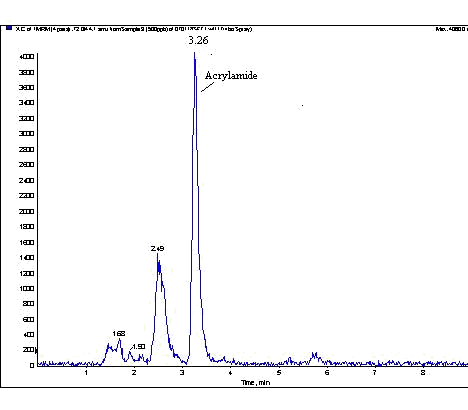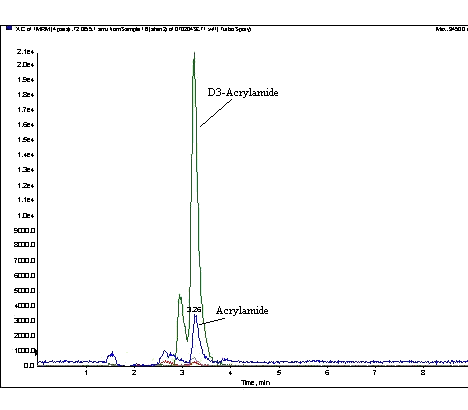http://www.chemistrymag.org/cji/2008/103012pe.htm |
Mar. 1,
2008 Vol.10 No.3 P.12 Copyright |
Shi Zhihong, Zhang Yanmei, Cao Yanzhong#
(College of Chemistry and Environmental Science, Hebei University; Key Laboratory of
Analytical Science and Technology of Hebei Province, Baoding, 071002; #Qinhuangdao
Entry-Exit Inspection and Quarantine Bureau, 39 Haibin Rd, Qinhuangdao, 066002)
Abstract A liquid chromatography/ tandem quadrupole mass spectrometry method was
established and validated for the determination of acrylamide in fried Chinese yam. This
method entails extraction with water, purification with Oasis HLB and Bond Elute LRC-PRS
solid-phase extraction (SPE) cartridges. The final extract was analyzed by LC/MS/MS. The
electrospray was operated in the positive ion mode, and quantitation was performed by
comparison of the peak area ratio of acrylamide with the internal standard, D3-acrylamide,
monitored using the MRM transitions at m/z 72 > 55 (acrylamide) and 75 > 58
(D3-acrylamide). The calibration curve of acrylamide showed good linearity in the range of
3
Keywords Acrylamide, LC/MS/MS, Fried Chinese yam, SPE, Determination
1. INTRODUCTION
In April 2002, scientists from the University of Stockholm and the Swedish National
Food Administration (NFA) reported the presence of acrylamide (2-propenamide) in a wide
range of fried or baked food samples [1,2]. From then on, acrylamide has
attracted worldwide attention because it has been classified as "potential
carcinogen" by the International Agency for
Research on Cancer (IARC) [3-5]. Model system studies have shown that
acrylamide is formed during the Maillard reaction of reducing sugars with asparagine [6,7],
when carbohydrate-rich food is processed at high temperature and low moisture conditions
associated with frying, baking and roasting. Up till now, research work has been focused
on various kinds of food, such as French fries [8], potato chips, biscuits and
coffee[9]. The presence of acrylamide in carbohydrate-rich food made us think
about the processing of Chinese herbs. Many kinds of Chinese herbs need to be processed
before it can be used. Some need to be processed by heating at certain temperature to make
it more fit to be used in the treatment of certain diseases. Whether or not acrylamide
will be produced during the heating process and what special function it exerts are the
questions attracting our research interest. In this work, we selected fried Chinese yam as
research object. Chinese yam (Latin name Rhizoma Dioscoreae) is the rhizome of Dioscorea
opposita Thunb. family Dioscoreaceae. Fried Chinese yam is made from yam by frying it to
yellow. Fried Chinese yam has the pharmaceutical effects of invigorating the spleen and
stomach as well as invigorating the kidney and preserving the essence [10].
The objective of the present study is to develop and validate a rapid,
highly sensitive, and reliable LC/MS/MS method for the determination of acrylamide in
fried Chinese yam. The established method will be useful in the study of acrylamide
formation during heating process of Chinese yam. So this work will contribute a lot in
overally understanding the relationship between acrylamide and human health.
2. EXPERIMENTAL
2.1 Reagents and materials
Acrylamide (>99.9%) was purchased from Amresco (Solon, Ohio, USA). 2,3,3-D3-acrylamide
(98%) was obtained from Cambridge Isotope Laboratories (Andover, MA, USA). Stock solutions
of acrylamide (1 mg/mL) and D3-acrylamide (1 mg/mL) were each prepared by dissolving the
compounds in methanol. The stock solutions were stored at 4ºC for a maximum
of 4 weeks.
The solid-phase extraction cartridges Oasis HLB (500mg, 6mL) was
provided by Waters (Milford, MA, USA) and Bond Elut LRC-PRS (500 mg, 6mL) was provided by Varian (Palo Alto, CA, USA).
The water used was purified with an Elix/Milli-Q water purification system (Millipore,
Bedford, MA, USA).
Fried yam was purchased from local drug store (Baoding, China).
2.2 Instrumentation
LC-MS/MS analyses were performed on an Agilent 1100 quaternary pump HPLC system (Agilent
Technologies, USA) coupled to a 3200 QTRAP (Applied Biosystems, Foster City, CA, USA)
consisting of an ESI as ionization source and a triple quadrupole as analyzer. Data
acquisition was carried out by Analyst 1.4.1 software.
A F160 plant pulverizer (Beijing, China) was used to make the plant
materials into powder. An MR23i high-speed centrifuge (Thermo Scientific, USA) was
employed to centrifuge the sample solutions. An SA31 shaker (Yamato Scientific Co., Japan)
was used to shake the sample solution.
2.3 Sample preparation
Fried Chinese yam was pulverized and homogenized. Subsample of 1 g was weighed into 50 mL
centrifuge tubes, and 10mL of water was added and the tube was shaken thoroughly for 15
min on a shaker. Then, the tube was centrifuged at 10000 rpm for 10 min. A 5 mL aliquot of
aqueous solution was loaded onto a conditioned Oasis HLB cartridge and was allowed to pass
through the sorbent material. Then, the column was eluted with 5 mL of 5 % methanol and 2
mL of the eluant was collected to pass through Bond Elut LRC-PRS cartridge, the eluent was filtered through a 0.2 m m
membrane filter.
2.4 LC-ESI-MS-MS conditions
The chromatographic separation of acrylamide was carried out on an Atlantis dC18 column
(150× 2.1 mm i.d., 3 m m, Waters, Milford, MA, USA) using a mixture of 0.1% formic acid
solution and 5% methanol (95:5, v/v) as mobile phase at a flow rate of 0.2 mL/min. The
sample volume injected was 20 mL. The column temperature was controlled at 30ºC.
The electrospray was operated in the positive ion mode and the
electrospray voltage was set to 5200V, the source temperature was 700ºC. Acrylamide
was identified using multiple reaction monitoring (MRM) set to records m/z 72 >72, 72
> 55 and 72 > 44. Monitored transitions for the internal standard (D3-acrylamide)
were m/z 75 >75, 75 > 58 and 75 > 44. Quantification was performed by comparison
of the peak area ratio of acrylamide with the internal standard, D3-acrylamide (100 ng·ml-1),
monitored using the MRM transitions at m/z 72 > 55 (acrylamide) and 75 > 58
(D3-acrylamide).
3.1 Selection of the extractant
Before the LC/MS/MS analysis, acrylamide has to be extracted from the sample matrices. In most analytical methods published so far, water has been used to extract acrylamide from many kinds of food samples because acrylamide is a good hydrophilic small molecule. Compared with other solvents such as methanol, water is far more efficient for the extraction of acrylamide. So, water was selected for further study.
3.2 Optimization of SPE procedure
Due to the complexity of the samples and the low levels of acrylamide, efficient clean-up steps are required to avoid interference from co-extractives. Solid phase extraction has commonly been used to achieve clean extracts. In this paper, various SPE cartridges were tested for the clean-up procedure and finally the polymeric columns Oasis HLB and Bond Elut LRC-PRS were selected. When Oasis HLB and Bond Elut LRC-PRS were used in combination, the interference peaks before acrylamide could be eliminated and high recovery could be obtained.
3.3 Calibration graphs and the limit of detection
Acrylamide was quantified by the isotope dilution method. This quantification methodology gives more precise data because a correction of changes in instrument performance is achieved. The addition of a known level of deuterated (D3-AA) standard to the samples allowed the quantification of the analyte. In all cases, 100 ng/ml of D3-AA was added into the sample tube before injection.
The calibration graph was plotted based on linear regression analysis of peak area ratio of acrylamide and D3-acrylamide(Y) versus concentration ratio of acrylamide and D3-acrylamide(X). The linear range for acrylamide was 3mg/kg-1000mg/kg. The regression equation for acrylamide was Y= 0.00782X+0.00563 and the correlation coefficient was 0.9991.
The limit of detection (LOD) was calculated as the amount of the injected sample which gave a signal-to-noise ratio of 3, and the LOD for acrylamide was 0.8 mg/kg.
3.4 Repeatability test
To test the repeatability of the method, the same sample solution was injected for five duplicate LC/MS/MS analysis. The relative standard deviation (R.S.D.) for the determined content of acrylamide was 1.03% and R.S.D. for the retention time was 2.67%.
3.5 Recovery test
Recovery experiment was carried out by spiking different amounts of acrylamide into raw yam and the spiked samples were treated according to the sample preparation procedure and determined by the established LC/MS/MS method. The results are shown in Table 1.
Table 1 Analytical results of recovery
Added (ng/ml) |
Found (ng/ml) |
Recovery (%) |
Average recovery(%) |
R.S.D. (%) |
500 |
498 |
99.6 |
99.3 |
0.95 |
500 |
491 |
98.2 |
||
500 |
502 |
100 |
||
100 |
99.6 |
99.6 |
100.5 |
1.28 |
100 |
100 |
100 |
||
100 |
102 |
102 |
||
25.0 |
24.2 |
96.8 |
102.3 |
4.73 |
25.0 |
26.1 |
104 |
||
25.0 |
26.4 |
106 |
3.6 Sample analysis
The established method has been sucessfully applied to the determination of acrylamide in
Chinese yam. Typical chromatograms for authentic acrylamide standard and fried Chinese yam
are shown in Fig.1 and 2. The average value of the content of acrylamide in fried Chinese
yam was 186.2 mg/kg based
on five duplicate analyses.

Fig.1 Chromatogram of Acrylamide standard

Fig.2 Chromatogram of fried
Chinese yam spiked with D3-acrylamide.
4. CONCLUSION
In this paper, the content of acrylamide in fried Chinese yam was reported for the
first time, and the value was lower than the reported data for fried and oven-cooked
foods, such as potato chips and French fries( 224-3700 mg/kg) [1,3]. Whether
or not the acrylamide formed in fried Chinese yam will do harm to human health or have
special effect on its pharmacological function is a question deserving further study.
Besides fried Chinese yam,there
are many kinds of fried Chinese herbs. The efficient SPE purification coupled to sensitive
LC/MS/MS determination ensured that the established method could be used for the general
survey of acrylamide content in other fried Chinese herbs.
ACKNOWLEDGMENTS Financial support from the National Natural Science Foundation of China (20575016) and the Natural Science Foundation of Hebei Province China (B2006000953) are gratefully acknowledged.
REFERENCES
[1] Swedish National Food Administration. http://www.slv.se,
2002,24 April.
[2] Tareke E., Rydberg P., Karlsson P., et al. J. Agric. Food Chem., 2002, 50, 4998-5006.
[3] International Agency for Research on Cancer [IARC], IARC Monogr Eval. Cancinog. Risks
Hum. 60 (1994) 389.
[4] Friedman M. J. Agric. Food Chem., 2003, 51: 4504-4526.
[5] Senyuva H. Z., GokmenV. Food Addit. Contam., 2005, 22(3): 214-220.
[6] Mottram D. S., Wedzicha B. L., Dodson A. T. Nature, 2002, 419:448-449.
[7] Stadler R. H., Blank I., Varga N. et al. Nature, 2002, 419: 449.
[8] Mestdagh F., Meulenaer B. D., Peteghem C. V. Food Chem. 2007, 100: 1153-1159
[9] Gokmen V., Senyuva H. Z. Journal of Chromatography A, 2006,1120: 194–198
[10] Ran M X, Guo J M. Modern Traditional Chinese Medicine Processing manual, Chinese
Materia Medica Publishing House, 2002, p252-253.
液相色谱-串联四极杆质谱法测定炒山药中的丙烯酰胺
石志红 张艳梅 曹彦忠#
(河北大学化学与环境科学学院, 河北省分析科学技术重点实验室
河北 保定 071002; #秦皇岛出入境检验检疫局,秦皇岛市海滨路39号,河北 秦皇岛 066002)
摘要 本文采用液相色谱-串联四极杆质谱法测定了炒山药中的丙烯酰胺含量。样品的水提液经Oasis
HLB 和 Bond Elute LRC-PRS 固相萃取柱净化后进样分析。电喷雾正离子MRM模式检测,内标法定量:丙烯酰胺m/
z 72 > 55 , 氘代丙烯酰胺m/ z 75 > 58。本方法中丙烯酰胺在3mg/kg-1000mg/kg 浓度范围内线性关系良好,相关系数0.9991。方法检出限为0.8mg/ kg(S/ N = 3),高中低三个水平的回收率在99.3
% - 102.3 % ( n =3),相对标准偏差在4.73%以下。
关键词 丙烯酰胺,液相色谱-串联四极杆质谱,炒山药,固相萃取,测定